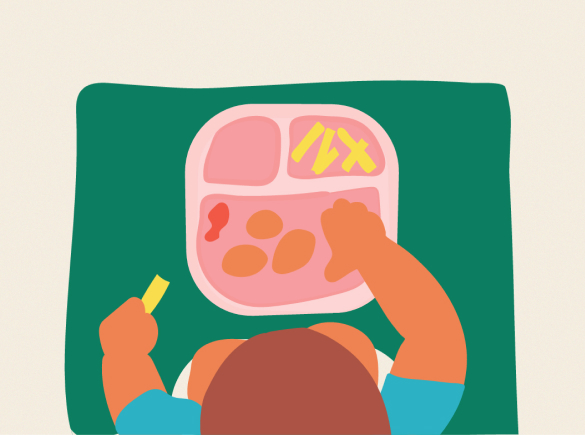Inside this article
Picky eating, or food fussiness, describes the tendency to eat a limited range of foods due to pickiness or reluctance to try new foods. A recent study has shown that fussy eating has a genetic component in children.
Whilst genetics plays a role, there are practical strategies parents can use to help their children build the confidence they need to try new foods. In this article, we’ll explore a few top tips you can use to help your child try new foods.
Division of Responsibility
This strategy, developed by American dietitian Ellyn Satter, is foundational for creating a positive mealtime experience and fostering a healthy relationship with food. According to this approach, parents are responsible for preparing nutritious meals and deciding “what” and “where” the food is served. The child’s responsibility is to decide how much to eat—or whether to eat at all. This division of responsibility helps reduce mealtime stress and empowers children to listen to their hunger and fullness cues, establishing a healthy feeding dynamic.
Create a relaxed eating environment
Once you’ve established this mealtime dynamic, the next step is creating a calm, stress-free eating environment. Encourage your child to eat at the dining table at the same time each day. Where possible, let your child serve themselves the amount of food they wish to eat. Playing soft background music can help reduce anxiety during mealtimes. Avoid distractions like the iPad and other electronic devices, which can disrupt the child’s ability to engage with food.
Messy Play
Let infants get messy and play with their food! This might surprise you, but research shows that children who confidently touch and engage with food are more likely to eventually eat it. So, if you have a baby or toddler at home who is curious about food and enjoys touching it before tasting it, let them explore! Try not to wipe their hands during meals—wait until they’ve finished eating to clean up.
Offer pudding regardless
Many parents assume that pudding should be offered as a reward for eating vegetables. However, research shows that this strategy can backfire with children viewing dessert as a prized item, and desiring it more. Instead, if you plan to offer dessert, do so regardless of how much or what your child eats from their main meal.
Take your child grocery shopping
With the rise of grocery delivery services, fewer children are visiting farmers’ markets or supermarkets. If possible, take your child shopping to increase their exposure to whole fruits and vegetables. This allows them to touch and smell the food in a low-pressure environment.
Cook with your children
This fun strategy works because both parent and child are relaxed. If your child is hesitant to try bitter-tasting vegetables, assign them age-appropriate tasks to “help out” in the kitchen. For example, toddlers can wash courgettes, while older children can slice them and stir them in a frying pan with supervision. You can also ask them to chop herbs and mix them with the vegetables. This builds familiarity and exposure without the pressure to eat.
Be a role model
Children need to see the most important people in their lives eating the same foods. This is why many dietitians advocate for family meals, where children eat the same foods as their parents. When children observe their parents engaging with and eating foods with complex textures and flavours, they will gradually build the confidence to taste new foods themselves.
Bottomline
While genetics may influence picky eating, these strategies can help children overcome fussy eating. By establishing a positive feeding environment, encouraging exploration and being patient, parents can support their children in gradually expanding their range of accepted foods. Remember, it’s important to remain consistent and not pressure your child. Learning to enjoy new foods is a gradual process that happens over time. With these strategies, you can lay the groundwork for a more adventurous and confident eater.









